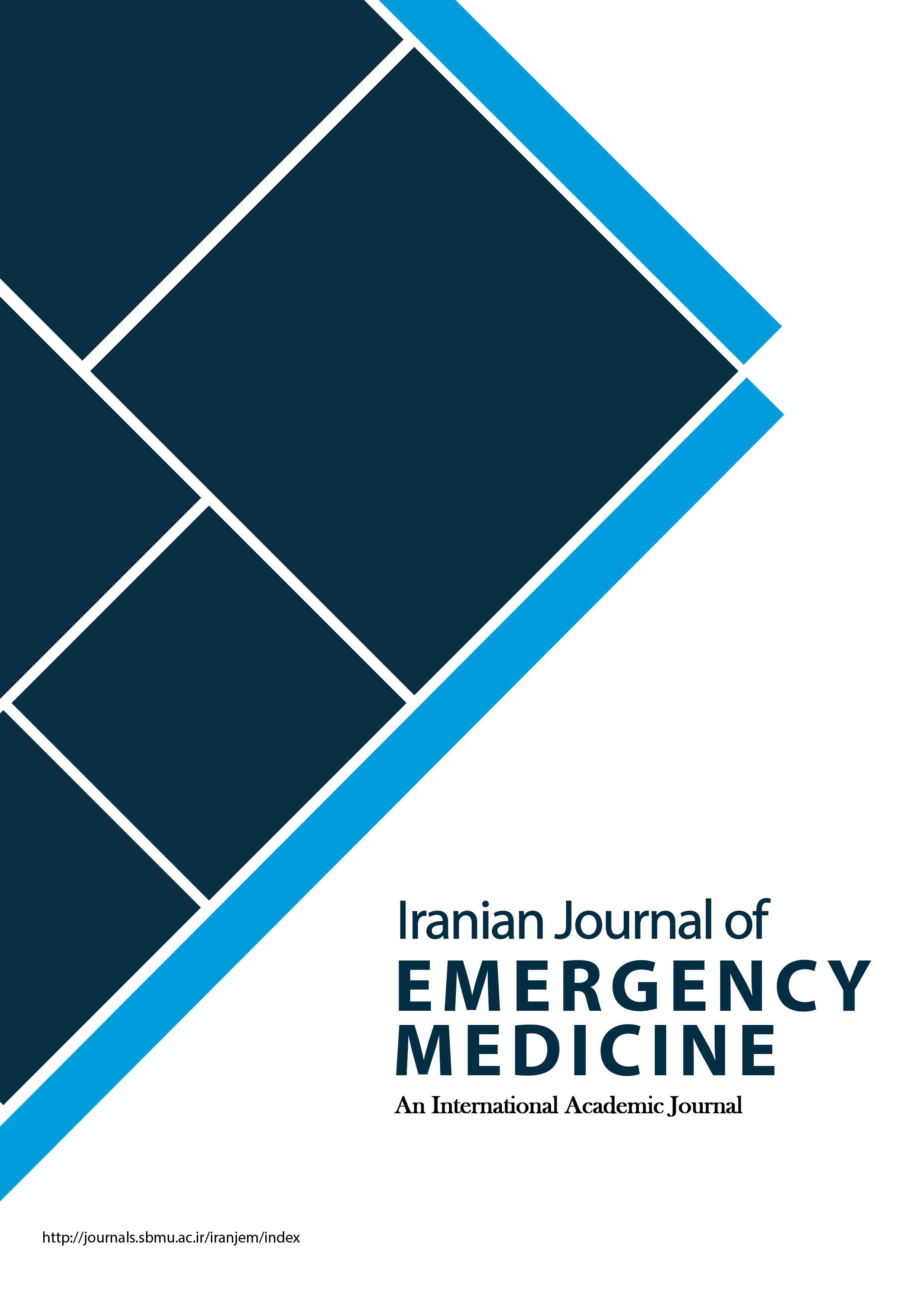The Way Residents Treat Patients with Decreased Level of Consciousness in the Emergency Department; a Clinical Audit
Iranian Journal of Emergency Medicine,
Vol. 6 No. 1 (2019),
23 February 2019
,
Page e14
https://doi.org/10.22037/ijem.v6i1.27914
Abstract
Introduction: Arcuate foramen anomaly is an anatomic variation in the first thoracic vertebrae that forms a space for passing of vertebral artery. Considering the role of this bony bridge in migraine development and its effect on prevalence of various types of pain in head, shoulder, and neck areas, as well as its importance in screw placement on the lateral mass of atlas, the present study evaluated the prevalence of this anomaly among those presented to the emergency department (ED) of Poursina Hospital, Rasht, Iran. Methods: The present study is a cross-sectional one, carried out on patients over 18 years of age that visited ED of Poursina Hospital, Rasht, Iran, in 2015 and underwent lateral neck radiography using census method. Data of the patients were gathered using their medical profile or by asking them on the phone, and recorded in a pre-designed checklist. Data were analyzed with the aid of SPSS version 24 and chi-square and independent t-test statistical tests. P-values less than 0.05 were considered as significant. Results: 1146 patients with the mean age of 37.95 ± 15.88 years were studied (69.2% male). Mean age was 36.05 ± 15.26 years among men and 14.21 ± 16.44 years among women (p < 0.001). The overall prevalence of arcuate foramen was calculated to be 9.6% [95% confidence interval 7.89 – 11.30; 110 patients (74.5% male)]. This anomaly had a prevalence of 10.34% in men and 7.93% in women (p > 0.05). Conclusion: Based on the results of the present study, the prevalence of arcuate foramen anomaly was estimated to be 9.6% in Guilan province using lateral neck radiography. Its prevalence rate was 10.34% in men and 7.93% in women. Considering this prevalence rate, presence of this anomaly should be considered as a possibility in patients with complaints of head, shoulder, and neck pain.
- Consciousness disorders
- clinical audit
- practice guideline
- emergency medicine
- internship and residency
How to Cite
References
Raicevic R, Jovicic A, Dimitrijevic R, Surbatovic M, Marenovic T. [Septic encephalopathy--prognostic value of the intensity of consciousness disorder to the outcome of sepsis]. Vojnosanit Pregl. 2001;58(2):151-6.
Pfadenhauer K, Rittner J, Stohr M. [Sepsis: impaired consciousness of unknown origin as the initial symptom. Clinical aspects and pathophysiology of septic encephalopathy. Comment on the contribution by S. Schwarz et al]. Nervenarzt. 1997;68(12):1008-9.
Hung TY, Seow VK, Chong CF, Wang TL, Chen CC. Gabapentin toxicity: an important cause of altered consciousness in patients with uraemia. BMJ Case Rep. 2009;2009.
Arieli R, Arieli Y, Daskalovic Y, Eynan M, Abramovich A. CNS oxygen toxicity in closed-circuit diving: signs and symptoms before loss of consciousness. Aviat Space Environ Med. 2006;77(11):1153-7.
Baitello AL, de Assis Cury F, Espada PC, Morioka RY, de Godoy JM. Mortality in patients with loss of consciousness at the scene of trauma. Int J Emerg Med. 2010;3(2):91-5.
Cucchiara BL, Kasner SE, Wolk DA, Lyden PD, Knappertz VA, Ashwood T, et al. Early impairment in consciousness predicts mortality after hemispheric ischemic stroke. Crit Care Med. 2004;32(1):241-5.
Rogers G, O'Flynn N. NICE guideline: transient loss of consciousness (blackouts) in adults and young people. Br J Gen Pract. 2011;61(582):40-2.
Cooper PN, Westby M, Pitcher DW, Bullock I. Synopsis of the National Institute for Health and Clinical Excellence Guideline for management of transient loss of consciousness. Ann Intern Med. 2011;155(8):543-9.
Summaries for patients: management of transient loss of consciousness: National Institute for Health and Clinical Excellence guideline. Ann Intern Med. 2011;155(8):I38.
Kekec Z, Senol V, Koc F, Seydaoglu G. . Int J Neurosci. 2008;118(5):609-17.
Rivkin AM, Chawla S. Epoetin alfa for the Treatment of Combination Therapy–Induced Hemolytic Anemia in Patients Infected with Hepatitis C Virus. Pharmacotherapy: The Journal of Human Pharmacology and Drug Therapy. 2005;25(6):862-75.
Zehtabchi S, Abdel Baki SG, Omurtag A, Sinert R, Chari G, Malhotra S, et al. Prevalence of non-convulsive seizure and other electroencephalographic abnormalities in ED patients with altered mental status. Am J Emerg Med. 2013;31(11):1578-82.
Leong LB, Jian KH, Vasu A, Seow E. Prospective study of patients with altered mental status: clinical features and outcome. Int J Emerg Med. 2008;1(3):179-82.
- Abstract Viewed: 3930 times
- PDF (فارسی) Downloaded: 812 times
- HTML (فارسی) Downloaded: 49 times



